Aug 10, 2016 | Baltimore, currency, education
Last April, the Baltimore Green Currency Association, sponsor of the BNote, initiated an Indiegogo campaign to fund their next issue that would feature significant women in Baltimore history. Although the campaign fell a little short, an anonymous donor funded more than $10,000 of the balance to print the currency.
Notes are a local currency that can be used at participating businesses in and around Baltimore. Currently, there are over 230 businesses accepting the BNote for goods and services. Consumers can receive BNotes as change for a transaction or may visit one of the official cambios (money exchange locations) to exchange dollars for BNotes. For every $10 that is exchanged for BNotes, you will receive a 10-percent bonus, which means if you exchange $10 you will receive BN11. You can also exchange BNotes for dollars at a reverse rate (receive $10 for every BN11 in BNotes).
The first BNotes were issued in April 2011 featuring the designs of Fredrick Douglas on the BN1 note and Edgar Allan Poe on the BN5 note. The reverse of the notes features a Baltimore oriole (the bird, not a ball player) on the $1 BNote and a raven on the reverse of the $5 BNote. For this new issue, Douglass and Poe remain on the note but the design changed to incorporate the vertical bars of the Calvert coat of arms that is incorporated in the Maryland flag.
-

-
Baltimore BN1 BNote with portrait of Frederick Douglass
-

-
Back of Baltimore BN1 BNote featuring a Baltimore Oriole (batting leadoff)
-

-
Baltimore BN5 BNote with portrait of Edgar Allan Poe
-
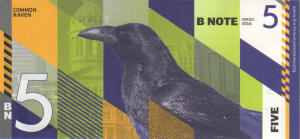
-
Back of Baltimore BN5 BNote with image of a Common Raven (Nevermore!)
The new BN10 and BN20 notes are similar in design with new colors on the background. Bea Gaddy is featured on the front of the BN10 and the Baltimore Checkerspot Butterfly, the official Maryland State Insect, on the reverse. Lillie May Carroll Jackson appears on the front of the BN20 note and a Blue Crab, the official Maryland State Crustacean, on the reverse.
Bea Gaddy was known as the Mother Teresa of Baltimore. A single mother of five who ended up in baltimore in 1964, she was discovered by a Baltimore attorney who encouraged her to go to college. Gaddy earned her bachelor’s degree in human services from Antioch University in 1977.
-
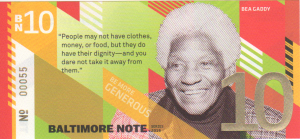
-
Baltimore BN10 BNote with portrait of Bea Gaddy
-
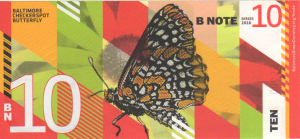
-
Back of Baltimore BN10 BNote with image of a Baltimore Checkerspot Butterfly, the Maryland State Insect
Gaddy saw the need to help others and joined the East Baltimore Children’s fund where she used her own home as a distribution point for clothing and food for the poor. She founded a homeless shelter which eventually became the Bea Gaddy Family Center, which is still in operation today.
In 1981, using the $290 she won on a 50-cents lottery ticket, she bought enough food to feed 39 neighbors and eventually opened a community kitchen for the needy. From Thanksgiving dinners to opening furniture bank refurbishing used furniture and rehabbing abandoned row houses, Gaddy was a catalyst to help the poor in Baltimore. Eventually, she became an ordained minister to perform marriages and hold funerals at no cost to the families.
Gaddy was diagnosed with breast cancer in 1998. With the cancer in remission, Gaddy ran for Baltimore City Council in 1999 and won. Unfortunately, the cancer returned and she died in October 2001 at the age of 68. Even though Bea Gaddy is gone, her family and friends continue to help the poor in Baltimore using the same love and compassion Bea showed throughout her life.
Dr. Lillie May Carroll Jackson was born in Baltimore in 1889 and is consider the mother of the civil rights movement. From 1935 through 1970, Jackson was the president of the Baltimore chapter of the NAACP and at the forefront of nearly every fight to end Maryland’s Jim Crow laws. Through her leadership, the Baltimore NAACP sued to remove the color barrier from admissions to the University of Maryland Law School, won cases to force Baltimore public schools to grant equal pay to white and black teachers, and was fundamental to having Baltimore to be the first school system south of the Mason-Dixon line to integrate their schools following the landmark Brown v. Board of Education decision.
-

-
Baltimore BN20 BNote with portrait of Lillie May Carroll Jackson
-
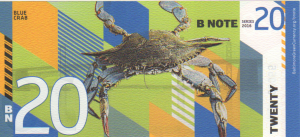
-
Back of Baltimore BN20 BNote with image of a Blue Crab, the Maryland State Crustacean
Jackson fought for equal pay and fair employment practices even though Maryland Governor Theodore McKeldin (R) was once quoted as saying, “I’d rather have the devil after me than Mrs. Jackson. Give her what she wants.” In the end, Jackson won most of the fights.
She is also credited with playing critical roles in the passage of federal civil rights legislation in the 1960s.
Jackson died from a heard attack in 1975. After she died, her will called for her Baltimore home to be turned into a civil rights museum. The museum opened in 1978 with memorabilia from Jackson’s life and documents chronicling her life’s work. It was the only museum named after a woman and the only civil rights museum in Maryland. The museum closed in the 1990s because it was too difficult to maintain as a private facility. The museum was transferred to Morgan University who refurbished the building and reopened it on June 11, 2016.
As part of the Indigogo campaign, I selected the option to receive the a full set of the second series BNotes with matching serial numbers. The notes I received, which feels like they were printed on heavy stock paper, a type of paper my wife said was “resumé” paper. All four notes feature serial number BN00055. For all you liar’s poker players, I call a full house.
What do you mean I can’t call a full house?!
Jul 3, 2016 | currency, education, Federal Reserve, news, video
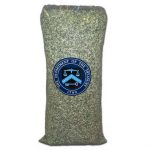
5 lb. bag of shredded currency contains $10K in cash
We have seen the many packages of shredded currency. From the little packages with $5.00 of shredded currency to 5 pound bags filled with approximately $10,000 shredded money, this was the primary way currency did not just get thrown away. Since 2014, the Federal Reserve has been working with recyclers across the country to turn that shredded cash into something else useful.
According to the Federal Reserve Bank of San Francisco, the Federal Reserve pushed for more recycling of currency in 2011. Since each Federal Reserve bank manages its own cash operations each works with local recyclers to provide the cash. In most cases, the recycler hauls away the shredded cash for no charge to the bank and turns it into other products.
Examples of what is done with the cash is that the San Francisco district supports burning of the shreds for “green power,” a fitting name for recycling U.S. currency. So does the Federal Reserve Bank of Philadelphia.
The story caught my eye was about the New Orleans branch of the Federal Reserve Bank of Atlanta that provides shredded currency to a company that composts the cash, mixes it with other soil so that it is used for growing vegetables.
If compost is not your idea of fun, how about using the shreds to make art:
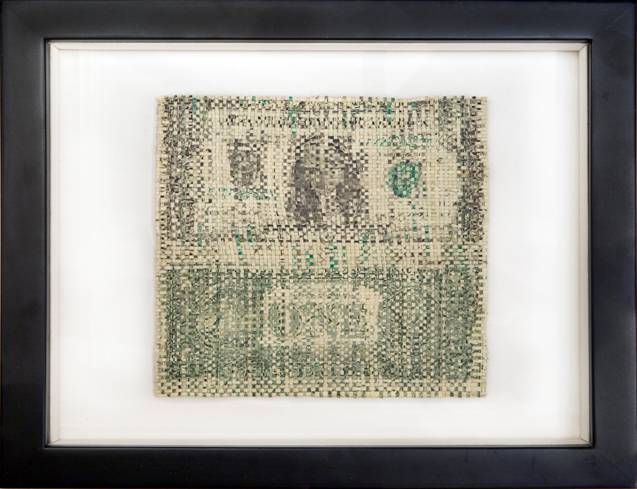
“Another Day, Another Dollar”
Artist: Jason Hughes
Sadat Art for Peace (2012): First Prize, Category: 2 Dimensional
Medium: American Currency
Jun 6, 2016 | advice, coins, counterfeit, currency, education, grading
This is final part of a 6 part series
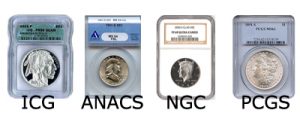 If you are uncomfortable trying to detect whether a coin is counterfeit or not, you might first consider buying from a reputable dealer who has return and/or buy back policies. If you buy raw coins and have questions, ask that the coin be examined by a third-party grading service such as Numismatic Guarantee Corporation, Professional Coin Grading Service, ANACSand Independent Coin Graders. These third-party grading services have a buy-back guarantee so that if the coin is ever found to be counterfeit after it was certified they will buy the coin from you at the price you paid. You may be asked to pay the grading fees. Some dealers may charge a service fee for submitting coins to the grading services on your behalf.
If you are uncomfortable trying to detect whether a coin is counterfeit or not, you might first consider buying from a reputable dealer who has return and/or buy back policies. If you buy raw coins and have questions, ask that the coin be examined by a third-party grading service such as Numismatic Guarantee Corporation, Professional Coin Grading Service, ANACSand Independent Coin Graders. These third-party grading services have a buy-back guarantee so that if the coin is ever found to be counterfeit after it was certified they will buy the coin from you at the price you paid. You may be asked to pay the grading fees. Some dealers may charge a service fee for submitting coins to the grading services on your behalf.
If you own coins that you may have questions about, either bring it to a dealer for an opinion or submit the coin to the third-party grading service yourself. NGC and PCGS have membership services that allow you to directly submit coins for authentication and grading. Members of the American Numismatic Association can register to directly submit coins to NGC. ANACS and ICG allows for collectors to directly submit coins for authentication and grading.

Sample of a PMG Holder

Sample of a PCGS Currency Holder
If you are buying through an online auction and you have any question about the coin, you are better off not trying to purchase it than trying to deal with returns. While there are quite a few reputable dealers who sell on these sites, it may take more than a month for the process from purchase to refund to occur. During that time, you will not have access to this money.
Remember, caveat emptor, “let the buyer beware.” Without a warranty or some type of assurance, such as a graded and encapsulated coin, the buyer takes all of the risk.
For sellers, caveat venditor, “let the seller beware.” Unless you expressly disclaim any responsibility, you will be held liable if the item is not true to its specification. You may also lose a future customer if that person feels cheated.
The Hobby Protection Act
Over the last number of years, we have seen when a hobby becomes popular and items increase in value, there are opportunists who will try to do whatever it takes to make money from the gullible and uneducated. This chapter was written to inform and educate you as to what to expect from those looking at your wallet and not to you as a valued customer so that you are not a victim.
When I discuss these issues I am eventually asked, “Aren’t we protected by the Hobby Protection Act?” In short, the answer is yes and no. The Hobby Protection Act of 1973 and was amended in 1988 represents an attempt at stopping counterfeits in all collectibles based on the way the world worked in 1973 and slightly updated in 1988. A lot has changed since then including the technologies available to counterfeiters.
The Hobby Protection Act requires that coins not made by the U.S. Mint include the word “COPY” somewhere on the surface. The law allowed law enforcement and buyers to go after the suppliers. The problem was that the suppliers were mainly in China and out of the reach of the U.S. criminal justice system. That changed in December 2014 when congress passed and the president signed the Collectible Coin Protection Act (Public Law No. 113-288). Under the new law, consumers and law enforcement can take civil action against the distributors and resellers of counterfeit coins.
The Federal Trade Commission has published draft rules to update the wa they enforce the (16 CFR Part 304) made by the passage of the Collectible Coin Protection Act.
FTC is required to publish the new rule in the Federal Register (81 FR 23219) and ask for public input on the new rules. These rules are the result of corrections made after a previous draft asked for comments on the costs, benefits, and overall impact of the rules.
Comments can be made on the FTC’s website or via postal mail as outlined on the website and in the Federal register.
Even though the law has changed, you should educate yourself and work with reputable people to build your collection. Education can be fun and the knowledge will help you better enjoy the hobby!
Credits
- Certified coins images courtesy of Dakota Coin.
- Image of the PMG holder courtesy of Paper Money Guarantee.
- Image of the PCGS Currency holder courtesy of PCGS Currency.
Jun 5, 2016 | counterfeit, currency, education
This is part 5 of a 6 part series
As opposed to the effort to detect counterfeit coins, new security features added to the currency paper makes it easier to detect counterfeits. First, examine the currency and compare the note you are questioning to one of the same denomination and series (date with possible letter added). Look at the quality of the paper and the sharpness of the printing. Look for how the note differs from the genuine note.
If the printing looks flat, darker, the colors do not look the same, and does not show the fine details that the original, you should check further. Look at the Federal Reserve and Treasury seals. On a genuine note, the saw-tooth points are clear, distinct, and share. Counterfeit notes may be uneven, rounded, or even broken. The boarder should be clear and sharp, even on a worn bill. The portrait should appear distinct from the background. If it looks like it is blending into the background, the note is likely counterfeit.
One of the tricks the counterfeiters use is to change the denomination in the corners hoping that they can pass the note to someone not paying attention. The most common alteration is changing a $1 note to look like a $10 bill by changing the numbers in the corners to be tens. You would be surprised how many times this works!

Counterfeit Currency Warning issued by the Baltimore Field office of the U.S. Secret Service in 2014.
One thing counterfeiters do is to try to print or copy genuine notes on paper that they bleached to remove the printing from a lower denomination. Bleaching will dull the security features but not eliminate them. Counterfeiters count on you not understanding the security features to pass the note.
First, look for the watermark. Every new note except to the $1 bill has a watermark of the portrait on the front of the bill. Hold the note up to the light and look for the watermark. You should be able to recognize the portrait as being the same portrait as printed on the note. If you are looking at a $20 bill, you should see the portrait of Andrew Jackson. If the watermark portrait is unclear, missing, or does not look like Jackson, you have a counterfeit note. If the watermark is the number “5” the paper is from a $5 bill and was reprinted by a counterfeiter.
Also look for the security thread that may be running up and down to the left or right of the portrait. The security thread should say “USA” and the denomination repeating on the thread. If you are looking at a $100 note and the denomination on the thread says “FIVE” then you are looking at a bleached counterfeit.
Counterfeit Detection Pens Do Not Always Work
Every time I visit a store and watch as the cashier use one of these currency pens to try to detect if I passed a counterfeit note, I laugh because it is not a dependable test.
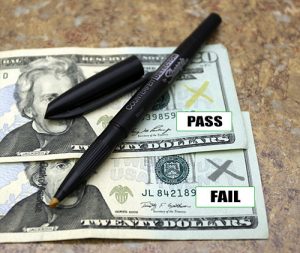
How to tell a counterfeit note using a counterfeit detection pen.
If you are trying to pass a bleached note, the ink will not react since it is real currency paper. If you are trying to pass an altered note, the ink will not react since it is real currency paper.
You can also make a genuine note look like a counterfeit by spraying starch that you would use to iron shirts on the note. Spray the starch on the note and use a warm iron get it to stick to the note. When you try to use the note and the cashier uses a counterfeit detection pen, the ink will change colors and you will be accused of trying to pass a counterfeit note.
The only way to reliably detect counterfeit currency is using the embedded security features.
To learn more about detecting counterfeit currency, the U.S. Secret Service and the Bureau of Engraving and Printing created the U.S. Currency Education Program to raise awareness about how to use the design and security features of U.S. currency. You can find a lot of resources at uscurrency.gov including an online training module that you can download for a reference.
If you receive a counterfeit note, do not return it to the person who gave it to you. Gather as much information as you can such as the description of the person, the description of anyone with that person, license plate and make of the car they might be driving, and call the police or contact your local U.S. Secret Service field office. Try not to handle the note. Rather, put it in something to protect it, like an envelope and give it to the police when they arrive to investigate.
Remember, in the United States it is illegal to posses counterfeit notes that are not marked as counterfeit or defaced in a way that make is clear the note is note genuine.
Finally, in the last installment we discuss resources you can use if you do not trust your own judgement.
Jun 4, 2016 | coins, counterfeit, education
This is part 4 of a 6 part series
Specific gravity is a way to determine the density of an object—or in this case, a coin. The denser an object is, the heavier it feels. In plain language, the density of an object describes how many molecules are packed together in the area. Since gold is one of the densest materials, gold feels heavier than it looks.

Basic illustration of measuring for Specific Gravity.
To do this test, you need a scale accurate to 1/100th gram, distilled water, a clean container to hold the water, and some way to suspend the coin in the water that does not add to its weight. One way to suspend the coin would be to create a suspension system using sewing thread to make a harness that will hold the coin parallel to the scale, and something to hold up the coin. If you use something other than thread that would add weight and displace more water, you will have to account for the harness. A wooden dowel can be used and laid across two stacks of books or bricks that are of the same height.
First, weigh the coin before doing anything else to get a reference “dry” weight. Then place the coin in the harness, suspend it over the scale, and with the empty container on the scale. Note where the coin sits in the container then remove the coin. Fill the container with distilled water so that it would be about a half-inch higher than the coin then tare the scale—set the weight so that it reads zero.
Now take the suspension system and carefully suspend the coin in the water. When the coin settles in the water, check the side facing down for air bubbles. If there are air bubbles, carefully tilt the coin using the thread to release the bubbles. One way to do this is to grab the threads of the harness with tweezers.
When the coin is still, the weight showing on the scale is weight of the water that was displaced when you suspended the coin in the water. Then you can calculate the specific gravity of the coin by dividing the dry weight by the weight of the displaced water (or dry weight/wet weight). Now you have the specific gravity of the coin.
This calculation may be deceiving because the coin may not be a solid value. An additional calculation would have to be made to account for the other metals in the coin, or you can search the Internet to find tables of the expected specific gravity for the coin you are testing.
Once you have the specific gravity, it should be within .02 percent of the reference value. If it is out of that range, the coin is likely a counterfeit. One way counterfeiters try to fool buyers is to use a lead-based core and plate the coin with the metal. Since lead is lighter than gold and heavier than silver, measuring the specific gravity will tell you if the metal used is the right one.
The following is a good video showing how you can do a basic home test for specific gravity:
Basic Reference
To help you with your tests, the following table will help you with the specific gravity of United States coins:
| Coin Type |
Alloy |
Specific Gravity |
| American Platinum Eagle Bullion |
.9995 PI |
21.40 |
| All 24-karat gold coins |
.9999 Au |
19.32 |
| American Gold Eagle Bullion |
.9167 Au, .30 Ag, .533 Cu |
17.45 |
| Early Gold Eagles |
.9167 Au, .0833 Ag+Cu |
17.45 |
| Gold Coins |
.900 Au, .100 Cu |
17.16 |
| Classic Head Gold Coins |
.8992 Au, .1008 Au |
17.14 |
| American Silver Eagle Bullion |
.999 Ag |
10.50 |
| Silver Coins |
.900 Ag, .100 Cu |
10.34 |
| Early Silver Coins |
.8924 Ag, .1076 Cu |
10.32 |
| Silver Trime |
.75 Ag, .25 Cu |
10.11 |
| Silver Clad Halves |
.400 Ag, .600 Cu |
9.53 |
| War Nickels |
.56 Cu, .35 Ag, .09 Mn |
9.25 |
| Clad Coinage |
.75 Cu, .25 Ni |
8.92 |
| Early Copper Coins |
1.00 Cu |
8.92 |
| Early Small Cents |
.88 Cu, .12 Ni |
8.92 |
| Bronze Cents |
.95 Cu, .05 Zn+Sn |
8.84 |
| Later Bronze Cents |
.95 Cu, .05 Zn |
8.84 |
| Modern Small Dollars |
.77 Cu, .12 Zn, .07 Mn, .04 Ni |
8.78 |
| Steel Cents |
Zinc-plated steel |
7.80 |
| Post 1982 Cents |
.975 Zn, .025 Cu |
7.17 |
Chemical symbols used:
- Ag: Silver
- Au: Gold
- Cu: Copper
- Mn: Manganese
- Ni: Nickel
- Pl: Platinum
In the next installment, we look at the visual inspection of currency.
Jun 3, 2016 | coins, counterfeit, education
This is part 3 of a 6 part series
Check the Coin’s Weight
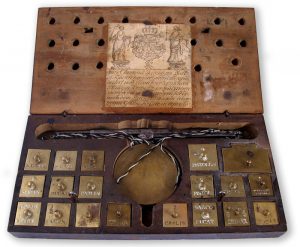
German “Bergische” Coin Balance and Weights 1765 by Johann Phillip Herbertz.
You will also need an authoritative reference that lists the weight of the coin you are weighing.
Weigh the coin. If you put anything on the scale other than the coin, such as a lint-free cloth to protect the coin, make sure you zero-out the scale before weighing the coin—called setting the tare. Your coin should be no more than one percent heavier than its reference weight and no lighter than 2-3 percent lighter for wear.
While the U.S. Mint has tried to be precise in making their coins, early attempts have been less than perfect. I have seen genuine circulated Large cents that have been heavier than the reference weight. Also, it is difficult to know how much of the coin is really worn. A coin that is too light may be a sign that the coin is made of a lighter metal, indicating a counterfeit.
Measure the Diameter and Thickness
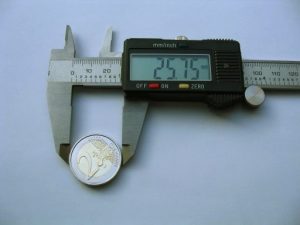
Digital caliper measuring a €2 coin.
Caliper rules can either be made using a mechanical dial or a digital readout with the rule marked to use a visual inspection. I prefer using a digital caliper that is accurate to at least one-tenth of a millimeter.
When you consult a reference to find the dimensions of a coin, you will find that most of the dimensions are in millimeters. It is very important that you remember this and use this scale when performing your own measurements.
To measure the diameter of the coin, hold the coin in your hand—wearing a cotton glove is optional—and make sure the claw end of the caliper fits snugly on the widest area of the coin. Once the measurement is set, you can read the measurement on the dial or digital display.
Do the same thing to measure the thickness.
A genuine coin will be within one percent of the diameter and the thickness will be 1-2 percent of the documented thickness depending on wear. However, this may not be a good test for early copper coins—Large cents and half cents. While congress and the U.S. Mint set standards for these coins, the lack of domestic suppliers forced them to have to buy the blanks from companies in England. Although specifications were provided, suppliers did not follow those standards properly. Many blanks were more like the British penny than based on the U.S. standard. You may find that some early large and half cents are larger in diameter or thicker than the information you find in some references.
Remember, wear and minting conditions can cause variations in these dimensions. It should be one part of the over all assessment.
Magnetism
If a coin is not made of an iron alloy, such as steel, then it should not be attracted to a magnet. Currently, all U.S. coins except for the 1943 Steel cents should not be attracted to a magnet. If the coin is attracted to a magnet, it might be made from a plated steel blank that was made to look like a genuine coin.
Counterfeiting technology has improved to where the counterfeiters are not using steel. Since there may be older counterfeits available on the market, this is a good test to find them.
Although the tests that are being discussed are nondestructive, for lesser coins or bullion, another test that can be used for silver coins is the magnetic slide test. The slide test can scratch your coin and is not recommended for those expensive collectibles.
The slide test uses a small slide that sits at a 45-degree angle from your surface and is made from a rare-earth magnet. Place the coin at the top of the slide and let if fall. If it is a genuine silver coin, it will slowly fall down the slide as if there was resistance. A counterfeit coin made without silver or that may be silver plated will either freely fall down the slide or slow slightly. If the coin is made of a magnetic metal, it will stick to the slide.
This happens because silver is a diamagnetic metal. A diamagnetic metal repels the magnetic field in a way that causes the field to surround the metal. The magnetic field causes a temporary charge to the silver that prevents the field from being repelled as in the case when you try to touch like-poles of a bar magnet. For the sliding coin, imagine that the magnetic field from the slide is forming an envelope around the coin as a type of electronic parachute slowing its fall.
Neodymium magnets are popular choices for all sorts of projects including those that use diamagnetic metals to show an object floating over a surface.
One problem with the slide test is that copper is also a diamagnetic metal. While copper’s diamagnetic properties are not as strong as silver’s, a silver-plated copper coin can fool the slide test. A test that shows the expected behavior but is not correct is called a false positive result.
Acoustic Ring
I remember when I was young and I learned how to rub the lip of a crystal drinking glass to make it sing. I also learned that this only worked for crystal and not the drinking glasses we used every day. It was amazing to try filling glasses with different amounts of water to make different sounds. Then I became discouraged when I saw someone play music using many crystal glasses on a variety show.
Gold and silver coins make a distinctive ring when struck. Wearing a cotton glove, balance the coin on the tip of your finger and strike it with a similar coin and listen to the ring. Wearing a glove prevents the oils on your finger from damaging the coin and prevents your skin from dulling the sound. Compare what you hear using a similar coin of the same type and similar wear. Sometimes this is called the “ping test.”
Of course conditions can change the sound, but if the sounds were drastically different, it would be a reason to question the coin’s authenticity. If this test is another failure amongst all of the others you conducted, you likely found a counterfeit coin.
In the next installment, we discuss a more complicated test called measuring for specific gravity.
Jun 2, 2016 | coins, counterfeit, education
This is part 2 of a 6 part series:

An example of a Morgan Dollar cut in half to match a date with a mintmark to have the coin appear something it is not.
Although laws are being proposed to help combat the problem, you should take the time to examine the coin, especially if you question its authenticity. Remember, none of these tests are fool proof and failing any one does not mean you have a counterfeit coin. You have to take all the evidence in its entirety to determine if the coin is real or not.
Before you look at the coin, you should be very familiar with the type or have a version of the coin you know to be authentic to compare with it. Although it would be easier of the coin was not in a grading service holder for visual comparison, at least you have a reasonable certainty that an encapsulated coin is authentic.
It helps to have a good magnifier to use to inspect your coin and cotton gloves to prevent the oils from your skin sticking to your prized collectibles.
Orientation
As you look at the coin, flip it over and look at both the obverse and reverse. How is the alignment of the coin? If you are looking at United States coins, you should be able turn it over and the reverse are in the opposite direction of the obverse. This is called “coin alignment.” Some countries produce coins in what is called “medal alignment” where the top of the obverse and reverse designs are in the same direction.
Just because a coin’s alignment is off does not mean the coin is a counterfeit. It is possible that the coin is genuine but was struck by misaligned dies to cause this error. Otherwise, keep the information in the back of your mind as you examine the rest of the coin.
-

-
U.S. coins are struck using coin orientation where if you looked at the reverse in a mirror, the reverse would look upside down.
-
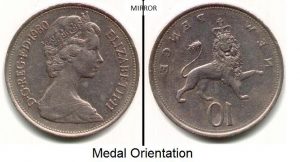
-
Some countries strike their coins using medal orientation where if you looked at the reverse in a mirror, the reverse would look right side up.
Examining the Edge
The edge of the coin is also known as the coin’s third side and the most underestimated area to look. Check the edge for a possible seam that could be the sign of a counterfeit that was cast in a mold rather than struck by a press. Also look for filing or other marks that would suggest the seams were smoothed.

Detecting counterfeit £1 coins, the genuine coin has edge lettering (left), the counterfeit does not.
With the recent rash of counterfeit British £1 coins, we learned that an easy way to tell the fakes from the real coins is to check the edge. If the coin’s edge does not include lettering, the coin is likely a counterfeit.
Surface Examination
Another clue to look for is if there seems to be a surface added to a coin. It will appear like someone put a veneer on top of a metal core. Coins should appear to be solid disks of metal. Even bimetallic coins look and feel like solid coins, even though they are made of two different parts. If you see this veneer-like effect, it is likely that the coin is a counterfeit.
Does the coin supposed to have edge lettering? Remember, some early varieties have coins that have edge lettering, while a later variety has reeds. Make sure you know which version of the coin you are examining and if the lettering on the edge matches the style of a genuine example. Collectors of Presidential dollars know that the lack of edge lettering can be an error by the U.S. Mint and not the sign of a counterfeit.
Some foreign coins have small tooth-like extensions on the surface near the coin’s edge called denticles. While the look of denticles could be different as the die wears, denticles on genuine coins have a sharp, consistent design. Denticles on counterfeit coins may be rounder, more inconsistent, and less dense on the coin—similar to reeded edges. This is where having a good knowledge of the coin you are examining will help you tell the difference between worn denticles produced by worn dies and a counterfeit coin.
Examine the legends and other features of the coin. Do the fonts look right? Is the image proper? Are these elements in the right places? While mistakes happen, it is extremely rare, if not impossible, for many of these elements to be off because of the way all mints make the dies. If the features are consistently incorrect, then the coin is likely to be a counterfeit.
What does the surface look like? Is it dull or have a dull appearance even though the coin is supposed to be of a higher grade? Are the features sharp or do they look rounded? Does the relief of the design look right or is it too flat? If the coin is supposed to be of a higher grade, the sharpness of the detail is important. Although there are coins that were not struck very well, called weak strikes, they will have sharper details than most counterfeit coins.
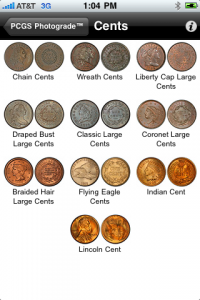
Click image to read my reviews of PCGS Photograde
On some coins you can see the evidence of the metal flow from the striking process. For some coins, it gives the coin a distinct look—like large silver dollars whose surface gives what is described as a “cartwheel effect” when examined under bright light. Be careful with this test because a lower grade coin has had its surface worn and will not show the cartwheel effect.
If the coin is a cast counterfeit, the surface may look bubbly. While there are examples of planchet (the coin blank) errors where the surface may bubble, these are usually in a small area and looks like small pimples on the coin. A bubbly surface from a cast coin may look similar to the gelatin mold you made where air became trapped inside.
Another sign of a counterfeit coin would be the showing of a different metal under a worn area. If the coin is supposed to be silver but a different color is showing through on a worn area, then it is likely that the coin was plated to give the appearance of silver but was made of a less expensive metal.
Check for Alterations
Finally, check for date and mintmark altering. On a genuine coin, the date and the mint mark looks like it is part of the coin and appears to be “growing” out of the surface. On a counterfeit coin, there are many ways to alter these elements by carving the date, called tooling, or physically cutting the elements from another coin and attaching it to a real coin. This type of alteration is common to change or add a mintmark to a coin.
Use your magnifier to look carefully at the date and mintmark. If there are too many sharp edges or looks damaged from being cut, I would be wary of the coin. Look at the mintmark and the potential grime around it. Does the placement of that grime look like it could have been accumulated over the years of circulation? Or does the pattern of grime not look natural and could be covering up a possible alteration?
-

-
Altering the mintmark and adding “V.D.B” to the reverse of a coin is another trick to fool the buyer.
-
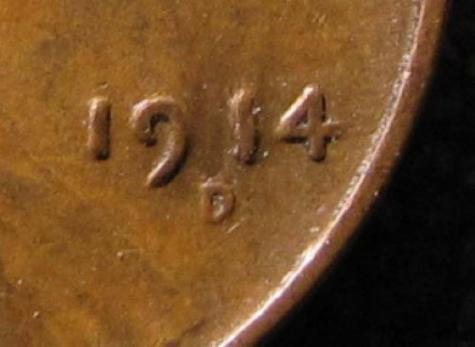
-
Look closely at the mintmark, it is clearly altered from the S you can see shadowed.
Also, know the difference between altered coins and genuine coins where the date was altered in the dies or the mintmark was repunched. Before express travel and fast package shipments, there were times when a branch mint needed to alter dies from another mint or alter dates on the dies so they can continue to strike coins. Rather than filling the die and punching the new date, the coiner would use a punch with the proper number and try to strike it in a way to eliminate most of the previous date. Repunched dates, also called over dates, were more common for coins struck outside of Philadelphia, but have happened in Philadelphia. When you see a catalog listing about a coin with a repunched date, it is written as the date of the coin followed by a forward slash followed by the digits that was previously on the coin. For example, in 1942, the Philadelphia Mint accidentally pressed a 1942 hub with 1941 dies creating the 1942/1 over date that were used in Philadelphia and Denver. Finding one in the lowest grade is worth a lot of money giving counterfeiters a good reason for counterfeiters to try to make one.
If you find a coin that looks like one mintmark is on top of another, or a mintmark looks doubled or tripled, it may be because it is a repunched mintmark. In addition to branch mint sharing dies, dies were shipped from Philadelphia without mintmarks. It was the job of the chief coiner in each branch mint to punch the mintmark into the dies. Sometimes the punch moves when struck giving it a doubled or tripled look. Other times a mintmark filled on the dies and another mintmark is punched over. Re-punched mintmarks are written the same as over dates in the catalogs.
One of the more famous re-punched mintmarks is the 1900-O/CC Morgan dollar. In this case, after the Carson City Mint was closed (CC mintmark), the reverse dies were shipped to the New Orleans Mint (O mintmark). The dies were filed and filled so that the “O” mintmark could be punched on the reverse but whoever did the work did not completely remove the “CC” mintmark. Looking under magnification, you can see the shadow of the original “CC” mintmark that was on the die.
Re-punched dates and mintmarks occurred more often than the U.S. Mint would like to admit. If the coin you are examining has one of these errors, check a reference to see if the it is known. While not finding it in a reference does not mean the coin is counterfeit, it is enough evidence to question whether the coin is genuine of counterfeit.
In the next installment, we discuss what to look for in weight and measurements.
Jun 1, 2016 | coins, counterfeit, education
Detecting Counterfeits
This is first article of a 6 part series:
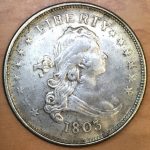
This counterfeit 1803-dated dollar was recently offered in a Hong Kong flea market for less than $3.
There has been a rise in counterfeiting of both collectible and circulating coins. The biggest source of counterfeit collectable coins has come from China. In some cases the counterfeiters had purchased the presses and other machines from the U.S. Mint and other government mints after they were replaced with more modern machines through government surplus sales, providing a supply of machines that could strike high quality coins.
To add to the problem, at one time the U.S. Mint did not fully deface used dies after its useful life. Rather, they would carve an “X” in the surface leaving large areas of the design showing. These cancelled dies made it out of the various branch mints as souvenirs and have been available on the open market. Counterfeiters have purchased these dies, mostly Morgan dollars, and use them as the basis to create their own dies that have fooled even the most experience numismatist.
Today, the U.S. Mint grinds the design completely off of all cancelled dies.
Starting in 2010, Great Britain began having problems with counterfeit £1 coins entering circulation. Even though the British law enforcement community has explained how to detect counterfeit £1 coins, they continue to fool the public. Although arrests were made in the rural areas of Great Britain in 2012, it is estimated that one in 30 £1 coins in circulation are counterfeit.
In 2017, the Royal Mint will issue a bi-metallic 12-sided £1 coin with anti-counterfeiting micro-engraving and milled edges to deter counterfeiting.

Detecting counterfeit £ coins, the genuine coin has edge lettering (left), the counterfeit does not.

In 2017 the Royal Mint will issue a bi-metalic 12-sided coin with microprinting.
Throughout the rest of Europe, they have been fighting against counterfeit €2 coins. Counterfeiters in Greece and Turkey had access to surplus presses and other material to strike a coin that looked very similar to standard €2 with the standard Greece reverse. News reports speculate that the coins were made with stolen material.

Counterfeit €2 coins were found in Italy.
To prevent counterfeiting, the Royal Canadian Mint (RCM) has introduced laser micro-engraving to their new $1 (Loonie) and $2 (Toonie) coins. On the $1 coin, a circle above the image of the common loon on the reverse is micro-engraved with an image of a maple leaf. On the reverse of the $2 coin, there are two circular micro-engraved images of a maple leaf and a virtual image using an angled design at the top of the design. The RCM hopes these fine details added to the Loonie and Toonie will prevent them from being counterfeited.
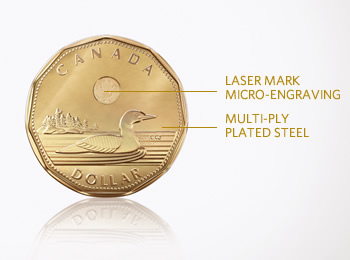
New anti-counterfeiting features of the Canadian dollar coin.
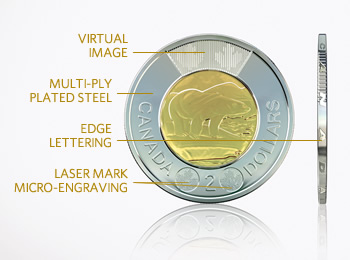
New anti-counterfeiting features of the Canadian two-dollar coin.
The U.S. Mint does not have plans or the legal mandate to include anti-counterfeiting measures on coins. This may be because the dollar coin does not circulate in the United States and the cost of counterfeiting lower denominations are too expensive to be profitable. However, that does not mean that it will not be a possible to profitably counterfeit United States coins in the future.
There are ways to do your own testing to see whether the coin you are questioning is real or counterfeit. In the next installment, we discuss what to think about when visually examining your collectible coins.
Credits
- Image of counterfeit 1803 dollar courtesy of Donn Perlman.
- Image of counterfeit UK pound coin courtesy of BBC News
- Image of the new £1 coin to be issued in 2017 courtesy of the Royal Mint
- Image of counterfeit €2 coin courtesy of The Daily Mail
- Images of the Canadian coins courtesy of the Royal Canadian Mint
May 24, 2016 | advice, coins, education
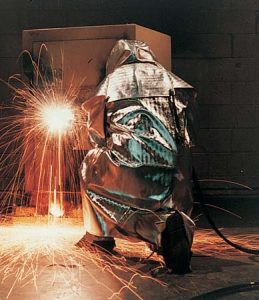 Those who follow my Twitter feed (@coinsblog) will notice that I have been posting links to stories about how the current Libyan government is trying to break into the vault once controlled by Muammar Gaddafi. The vault is supposed to have gold and silver coins estimated at $184 million. Libya is desperate to access this cache that the central bank hired professional safecrackers to open the vault.
Those who follow my Twitter feed (@coinsblog) will notice that I have been posting links to stories about how the current Libyan government is trying to break into the vault once controlled by Muammar Gaddafi. The vault is supposed to have gold and silver coins estimated at $184 million. Libya is desperate to access this cache that the central bank hired professional safecrackers to open the vault.
We can learn a lesson from this story. Aside from being someone that others want to terminate with extreme prejudice, what will happen with your collection and other protected collectibles should something happen to you?
Do you have a safe deposit box or a safe in your house where you keep your collection? What is your plan should something happen? You don’t have to be of the Baby Boomer generation to worry about what would happen. Even before I was eligible to be a member of AARP, I would ask what their contingency was if I was hit by the proverbial cross-town bus?
Even though the response was a nervous laugh and an exclamation that a lot of institutional knowledge would be lost if I was hit by a bus, the fact remains that even though I am healthy I cannot predict what could happen.
What would happen at home if something would happen to me? When considering both my electronic life and my collection, I had to think about how to tell my survivors what to do with everything. Electronically, I have a contingency plan that would allow my survivors to access files, websites, and other assets. For my collection, I have it documented and instructions as to what to do.
Although you would like to live on or help your survivors, the fact remains that not only do they not have your interests but will not know what to do with that album of Morgan dollars you spent years collecting.
There are so many consideration that you may want to consult one of the books on the market about selling a coin collection. While the books were written to guide those who inherit coin collections, it will give those planning for their estate what your heirs will have to deal with when the time times.
The two books you should read are:
Failure to plan is a plan to fail. Give your heirs a break and come up with a plan that they can follow to take care of your collection when you cannot.
May 11, 2016 | administrative, education
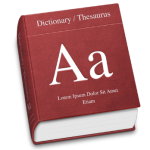 Behind the scenes I am working on a few projects including the ability for collectors to have access to my dictionary wordlist where ever they are. I will have an announcement in a few weeks but in the mean time I am collecting reference information and finding words missing from my Numismatic Dictionary. After a while, I will reformat my list and add them.
Behind the scenes I am working on a few projects including the ability for collectors to have access to my dictionary wordlist where ever they are. I will have an announcement in a few weeks but in the mean time I am collecting reference information and finding words missing from my Numismatic Dictionary. After a while, I will reformat my list and add them.
Here is today’s list of new words:
My word of the day is exergue. An exergue is the area below the main design that is separated by a line and often bears the date. An example of an exergue would be on the reverse of the Buffalo nickel or the obverse of the Standing Liberty quarter. I forgot what I was reading when I came across the word discussing the differences in the Type 1 and Type 2 Buffalo nickels.

Reverse of a 1913 Type 2 Buffalo nickel showing the “FIVE CENTS” in the exergue.
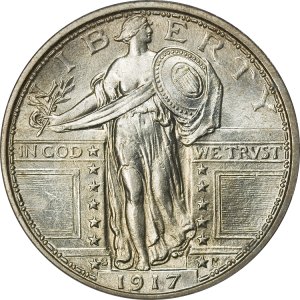
Obverse of a 1917-S Type 1 Standing Liberty Quarter with the date in the exergue.
It is always good to learn something new!
If you think there is a mistake or a word has been left out please contact me and let me know. Thank you!
Coin images courtesy of Wikipedia.













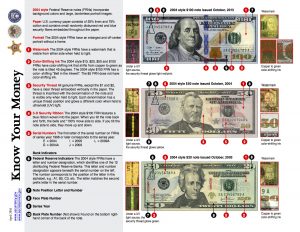

















 Those who follow my
Those who follow my 



